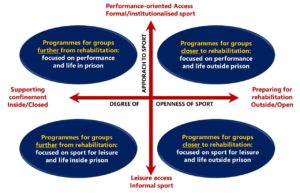
Prison/ Prisioners: Institution that protects society from offenders and preserves social peacefulness. It’s a disciplinary comprehensive apparatus” that controls all individual aspects and disciplines delinquent in their habits and customs. It also educates the body and mind and should make individuals able to behave without compromising the social contract.
Contribution: Sport can be an efficient tool to enhance the effectiveness of well-structured rehabilitative and educational programmes:
International endorsement:
Dimension of Sport in prison (179)
Sport provision needs to respond to individual needs, with a focus on health, well-being and rehabilitation:

Planning activities:
Other tips:
Basketball in prisons
(Fundación Real Madrid)
More information:
Article- Prisons and Real Madrid will promote Sport and its values among prisoners. Click Here
Programme in prisons. Click Here